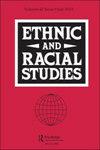移民危机的社会余震:多米尼加共和国的种族威胁和种族漂移
IF 2
2区 社会学
Q1 ETHNIC STUDIES
引用次数: 0
摘要
在本文中,我探讨了一个接受移民的拉丁美洲社会的种族结构如何影响其成员在面对被认为是外来种族的到来时可用的策略。利用调查数据,我探讨了2010年海地地震后,多米尼加人如何应对流离失所的海地人的迅速涌入,并发现在地震后进行的调查中,多米尼加人更倾向于将自己认同为印度人这一流行的民族主义身份类别。我认为,这标志着在多米尼加种族秩序受到日益严重的种族威胁的时刻,反海地情绪的加剧,而这种转变是由拉丁美洲的种族动态推动的,这种动态允许在围绕梅斯蒂扎伊逻辑构建的社会中,在被列出的种族类别之间流动。感谢Eduardo Bonilla-Silva、编辑和匿名审稿人在撰写本文过程中提供的有益建议。我感谢LAPOP和他们的资助者。这篇论文的一个版本在2023年的南方社会学协会会议上发表。杜克大学校园IRB批准的IRB豁免筛选,协议#2020-0130。披露声明作者未报告潜在的利益冲突。注1关于LAPOP抽样的公开、不受限制的调查数据和技术信息,请访问:http://www.vanderbilt.edu/lapop/core-surveys.php.2与LAPOP的沟通证实了这一点。本文章由计算机程序翻译,如有差异,请以英文原文为准。
The social aftershocks of a migration crisis: racial threat and racial drift in the Dominican Republic
ABSTRACTIn this paper, I explore how the racial structure of an immigrant-receiving Latin American society informs the strategies that are available to its members when they are confronted with the arrival of perceived racial outsiders. Using survey data, I explore how Dominicans responded to the rapid influx of displaced Haitians in the aftermath of the 2010 earthquake in Haiti, and find that when surveyed after the earthquake, Dominicans were more likely to self-identify with the popular and nationalist identity category of indio. I argue that this signaled a heightening of anti-Haitian sentiment in a moment of perceived increased racial threat to the Dominican racial order, and that this shift was facilitated by Latin American racial dynamics that allow for movement between enumerated racial categories in societies structured around the logic of mestizaje.KEYWORDS: Raceracial threatanti-blacknessimmigrant receptionmestizajeDominican Republic AcknowledgementsI thank Eduardo Bonilla-Silva, the editors, and the anonymous reviewers for their helpful suggestions in the production of this manuscript. I thank LAPOP and their funders. A version of this paper was presented at the 2023 meeting of the Southern Sociological Association. Screening for IRB Exemption granted by Duke Campus IRB, Protocol #2020-0130.Disclosure statementNo potential conflict of interest was reported by the author(s).Notes1 For public, unrestricted survey data and technical information about LAPOP sampling, visit: http://www.vanderbilt.edu/lapop/core-surveys.php.2 Communications with LAPOP confirmed this.
求助全文
通过发布文献求助,成功后即可免费获取论文全文。
去求助
来源期刊

Ethnic and Racial Studies
Multiple-
CiteScore
4.60
自引率
8.00%
发文量
258
期刊介绍:
Race, ethnicity and nationalism are at the heart of many of the major social and political issues in the present global environment. New antagonisms have emerged which require a rethinking of traditional theoretical and empirical perspectives. Ethnic and Racial Studies, published ten times a year, is the leading journal for the analysis of these issues throughout the world. The journal provides an interdisciplinary academic forum for the presentation of research and theoretical analysis, drawing on sociology, social policy, anthropology, political science, economics, geography, international relations, history, social psychology and cultural studies.
 求助内容:
求助内容: 应助结果提醒方式:
应助结果提醒方式:


